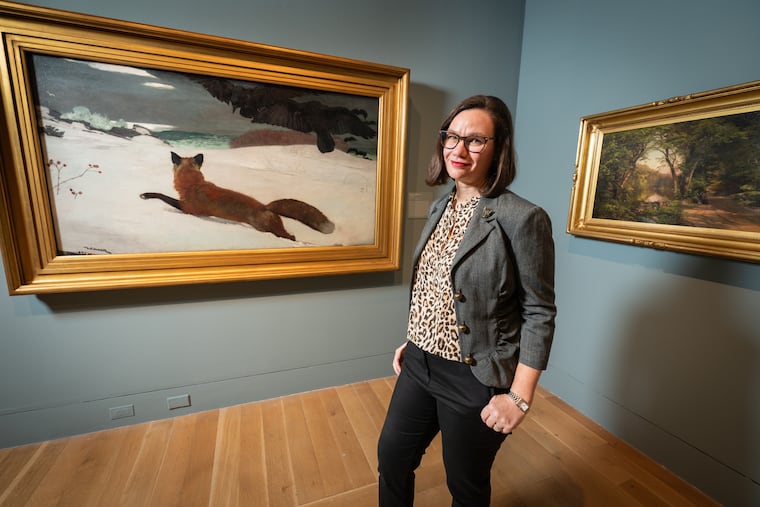Is this painting of a fox one of the greatest works of American art?
A preview of curators' favorites at PAFA's new "Making American Artists: Stories from the Pennsylvania Academy of the Fine Arts, 1776–1976" show.

The Fox Hunt, Winslow Homer’s 1893 oil on canvas, delivers more than just a realistic depiction of a sleek animal paused on its trek through the snow by the sea. Considered one of the top works by one of the country’s top artists, The Fox Hunt is often discussed as one of the most powerful paintings in the history of American art.
Look closely at the scene, says Anna O. Marley, chief of curatorial affairs at the Pennsylvania Academy of Fine Arts and you’ll realize: The fox is utterly alone, hemmed in by the sea and the rocks, hampered by the too-deep snow, as a flock of crows descends — “It’s about to be attacked. It’s devastating,” she said. “And it touches viewers of all ages and backgrounds.”
The fox is just one of over 100 paintings now on display at PAFA as part of Making American Artists: Stories from PAFA 1776-1976. Selected from PAFA’s archive of 16,000 items, the exhibit aims to showcase the most influential and powerful works that underpin the foundation of American art, offering a more complete “picture” of art-making during the nation’s first 200 years.
The show, which includes works by long-celebrated artists like Georgia O’Keeffe, Edward Hopper, and Andrew Wyeth, also showcases artists that Marley believes deserve to be better known. The purpose is to further “new narratives in art history, embracing stories about women and LGBTQIA+ and artists of color, and ask: What did it mean to be an American artist when the nation was founded and then 200 years later?” she says.
If Homer’s snowbound fox doesn’t move you, there are plenty of other works that might, which can also stake a claim as iconic American art. As a part of the exhibition PAFA is sponsoring a virtual lecture series featuring three scholars who weigh in on the show’s most potent works. University of Pennsylvania’s Jonathan Katz, the country’s founding expert in queer art history, is excited for visitors to experience the marble sculpture, Puck on a Toadstool (circa 1856) created by Harriet Hosmer. On first glance, Hosmer’s seated cherub looks benign and sweet, but look again, Katz challenges, and you’ll see a “bratty, aggressive child. And those angel wings? Actually, they’re bat wings.” Katz is also struck by the figure’s upraised arm, which appears poised to hurl a grub at the viewer. Chronicled in old English lore, Katz reminds, Puck is not so much a happy spirit, as a trickster who is nongendered — like this sculpture.
Hosmer (1830-1908) dressed as a man, relocated to Rome, and thrived as a sculptor, then understood as a man’s profession. Katz says Hosmer’s work, “radiates the idea of social dissent — articulating lesbian and gender nonconformity years before we had the language for this.”
Thirty percent of the works in the exhibit are by women; 15 are by artists of color, including two works by May Howard Jackson — PAFA’s first female graduate of African ancestry. Dana Byrd, another scholar who participated in the lecture series, cites the power of Jackson’s 1899 sculpture Slave Boy. The bronze bust of an adolescent Black male “seems like it’s a way of rethinking the history of [historically enslaved] people. … We’re not meant to take in his body and think about the labor, we’re meant to see him as human,” said Byrd, an associate professor of art history at Bowdoin College.
Scholar Christiane Ayne Crouch, Bard College dean of graduate studies and an associate professor of history, another lecturer in the series, was also moved by May Howard Jackson’s sculpture, citing it for resisting stereotypes, and “not distilling millions of people into a single [abstracted] image. It’s one specific young man.”
Crouch also recommends Jackson’s other work in the exhibit — the landscape Morris Heights, N.Y. City, 1912. Seemingly painted from a high vantage point, the work contains graceful trees with luxuriant foliage reaching into the wide sky, which Crouch says, convey Jackson’s affection for that place and perhaps also, an affection for her work as an American artist, making powerful art.
It’s Georgia O’Keeffe’s Red Canna that Guatemalan-born Julio Galvez deems the most iconic. A PAFA graduate student specializing in sculpture and installation art, Galvez appreciates the oil painting’s vivid flowers. He believes the petals’ undulant folds, painted in 1923, were more than just a botanical magnification, but also a means of conveying subversive messages. It’s an aspect Galvez is trying to explore in his own art.
“Art’s powerful effect influences Americans, whether they realize it or not,” says Marley, who has placed two portraits at the entrance to the show, asking visitors to guess which one of the subjects is George Washington.
On the left is a portrait painted by PAFA cofounder Charles Wilson Peale, of a dapper colonial (white) man with his arm canted on his hip, meeting the viewer’s gaze with a kind of a “Oh, what now?” countenance. The other, painted by Gilbert Stuart, is unquestionably Washington. We only need to open our wallets and pull out a $1 bill to confirm. Both paintings, however, are portraits of Washington.
“This is what the show is about,” Marley says. ”Looking again to see, ‘Oh, maybe there’s more?’”
‘Making American Artists: Stories from the Pennsylvania Academy of the Fine Arts, 1776-1976′ is on display at the Pennsylvania Academy of the Fine Arts, Oct. 6 — April 2.
―
This article has been updated to correct a reference to the number of pieces in the Pennsylvania Academy of Fine Art’s archive. The correct number is 16,000.